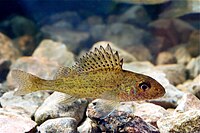
Photo from wikipedia
During the teleost ontogenesis, biotic and abiotic factors influence organs deformations. Despite of an important literature, the potential causes of deformities in fish are still poorly understood. Cultured fish in… Click to show full abstract
During the teleost ontogenesis, biotic and abiotic factors influence organs deformations. Despite of an important literature, the potential causes of deformities in fish are still poorly understood. Cultured fish in artificial conditions exhibit higher incidence of developmental impairments compared to wild ones. This study aims at describing exhaustively the deformity categories of newly hatched embryos of Eurasian perch and investigating at once all biotic and abiotic factors of two extremely different rearing systems [recirculating aquaculture system (RAS) vs. ponds] on their occurrence. The description and clustering of deformities according to the organs involved allowed not only to show that skeletal, cardiac and yolk anomalies are the most common ones, but also to highlight new functions undergoing developmental failure (locomotive, digestive and excretory systems). In total, 10 categories of abnormalities have been described. In addition, our data show a relationship between the cardiac and yolk deformities suggesting common causes. In a second part, we compared the incidence of deformities in the progeny of two distinct populations of fish, reared under extremely various conditions (RAS vs. pond). The total deformity rates did not differ between the groups but the nature of deformities was surprisingly different as the RAS reared fish (RRF) originating from fisheries presented a higher variety of deformity categories than the fish originating from Lorraine ponds (LPRF). Indeed, cardiac, yolk and skeletal axis deformities were more frequent in RRF embryos, whereas mouth abnormalities were preferentially represented in LPRF embryos. These findings may help understanding the potential causes of these developmental impairments in cultured animals and may lead to the improvement of husbandry conditions.
Journal Title: Journal of Zoology
Year Published: 2017
Link to full text (if available)
Share on Social Media: Sign Up to like & get
recommendations!